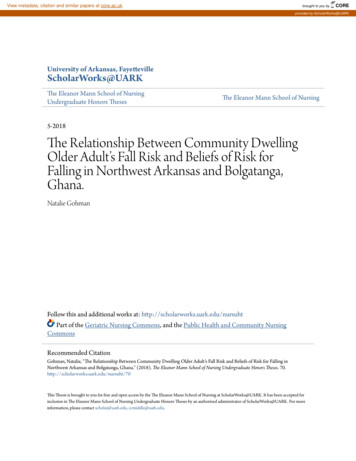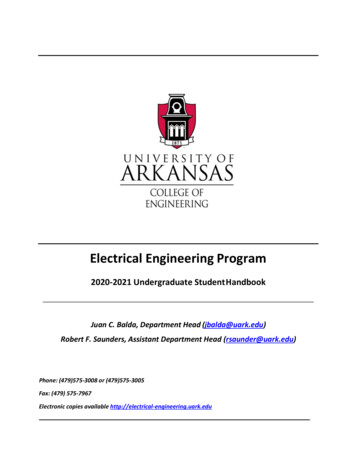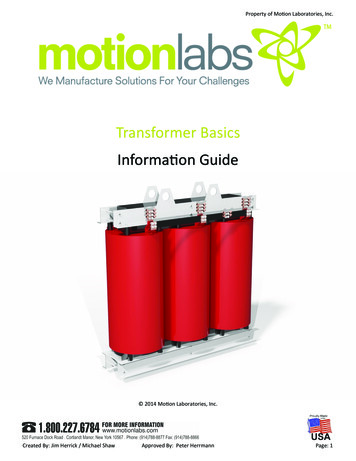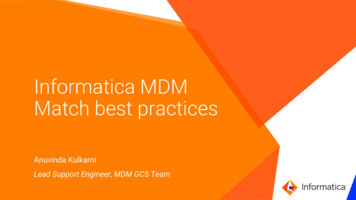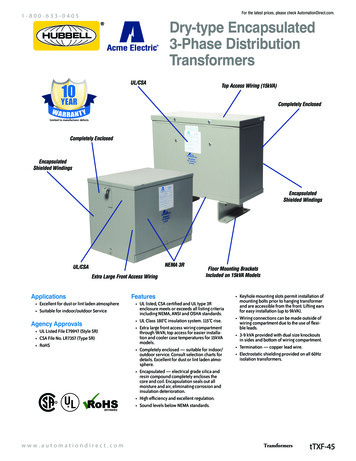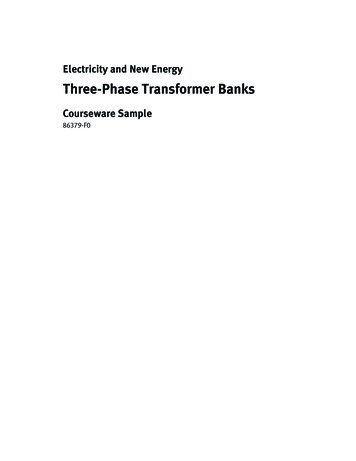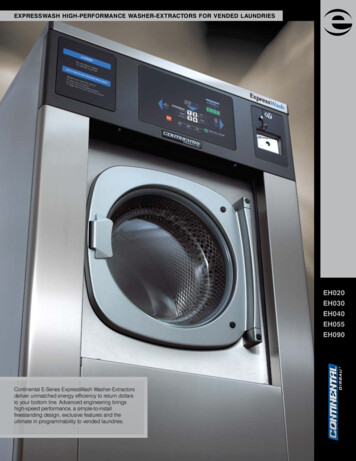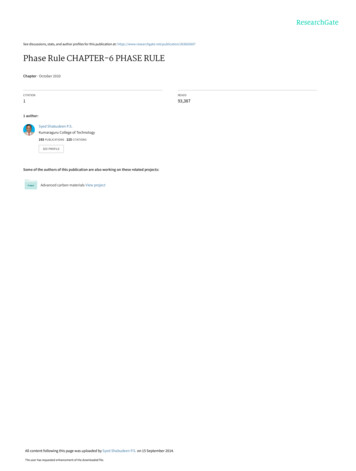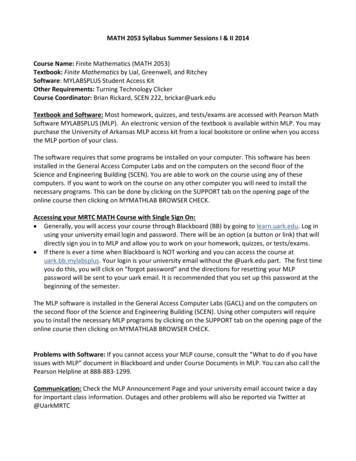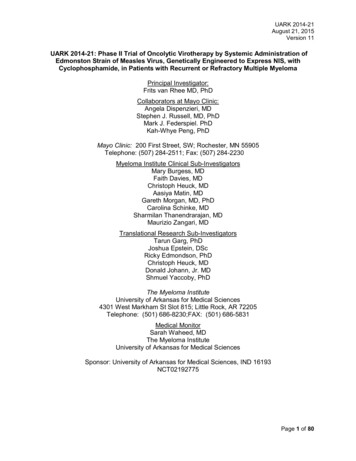
Transcription
UARK 2014-21August 21, 2015Version 11UARK 2014-21: Phase II Trial of Oncolytic Virotherapy by Systemic Administration ofEdmonston Strain of Measles Virus, Genetically Engineered to Express NIS, withCyclophosphamide, in Patients with Recurrent or Refractory Multiple MyelomaPrincipal Investigator:Frits van Rhee MD, PhDCollaborators at Mayo Clinic:Angela Dispenzieri, MDStephen J. Russell, MD, PhDMark J. Federspiel. PhDKah-Whye Peng, PhDMayo Clinic: 200 First Street, SW; Rochester, MN 55905Telephone: (507) 284-2511; Fax: (507) 284-2230Myeloma Institute Clinical Sub-InvestigatorsMary Burgess, MDFaith Davies, MDChristoph Heuck, MDAasiya Matin, MDGareth Morgan, MD, PhDCarolina Schinke, MDSharmilan Thanendrarajan, MDMaurizio Zangari, MDTranslational Research Sub-InvestigatorsTarun Garg, PhDJoshua Epstein, DScRicky Edmondson, PhDChristoph Heuck, MDDonald Johann, Jr. MDShmuel Yaccoby, PhDThe Myeloma InstituteUniversity of Arkansas for Medical Sciences4301 West Markham St Slot 815; Little Rock, AR 72205Telephone: (501) 686-8230;FAX: (501) 686-5831Medical MonitorSarah Waheed, MDThe Myeloma InstituteUniversity of Arkansas for Medical SciencesSponsor: University of Arkansas for Medical Sciences, IND 16193NCT02192775Page 1 of 80
UARK 2014-21August 21, 2015Version 11TABLE OF CONTENTSLIST OF COMMON ABBREVIATIONS . 4SCHEMA DIAGRAM . 51.0 PROTOCOL SUMMARY . 62.0 BACKGROUND AND RATIONALE . 72.1. Introduction . 72.2. MV-NIS: Description . 82.3. MM: Need for Alternative Therapies . 102.4. Safety of MV Vaccine in MM Patients Despite Suppression of HumoralImmunity . 112.5. MM: Susceptibility to MV-NIS Oncolytic Virotherapy . 122.6. Modulating the Anti-MV Immune Response by Cy in pre-clinical studies.37 . 132.7. Pre-Clinical Data: MV-NIS Toxicity and Biodistribution Studies . 142.8. Experience with MV-NIS in MM Patients . 193.0 OBJECTIVES . 283.1. Primary Objectives . 283.2. Secondary Objectives . 284.0 PATIENT ELIGIBILITY . 294.1. Inclusion Criteria . 294.2. Exclusion Criteria . 315.0 TREATMENT PLAN . 315.1. Dose Escalation Schedule . 315.2. Treatment Schedule . 325.3. MV-NIS Dose Escalation Rules (applicable to all steps of the Rapid DoseEscalation Phase) . 345.4. MV-NIS Dose Escalation Rules (applicable to all steps of the Slow DoseEscalation Phase) . 345.5. Dose De-Escalation . 365.6. Anticipated Toxicity . 365.7. DLT – Definition (Table 8). . 376.0 SCHEDULE OF EVALUATIONS (TABLE 9) . 387.0 DOSAGE MODIFICATION BASED ON AEs . 407.1. Rules for Dose Escalation and De-Escalation . 408.0 ANCILLARY THERAPY. 418.1. Supportive Care . 418.2. Monitoring . 418.3. Patient Education . 418.4. Disease Communication . 428.5. Concurrent Enrollment . 429.0 AE REPORTING AND MONITORING. 429.1. AE Information . 429.2. Assessment of Attribution . 439.3. Expected vs. Unexpected . 439.4. AE Grading. 4310.0 TREATMENT/FOLLOW-UP DECISION AT EVALUATION . 4410.1. Discontinuation of Therapy . 44Page 2 of 80
UARK 2014-21August 21, 2015Version 1110.2. Subject Replacement . 4410.3. Response Monitoring . 4410.4. Observation: Study Non-Completion. 4510.5. Discontinuation Due to Toxicity . 4510.6. Cancelations . 4511.0 ANCILLARY STUDIES . 4511.1. Assessment of Viremia . 4511.2. Assessment of Immune Competence . 4511.3. Assessment of Peripheral Immune Response . 4512.0 STATISTICAL CONSIDERATIONS AND METHODOLOGY . 4612.1. Overview . 4612.2. Maximum Tolerated Dose (MTD) . 4612.3. MTD determination . 4612.4. General Statistical Considerations: . 4612.5. Analysis Plans. 4713.0 SUBSET ANALYSES FOR WOMEN AND MINORITIES: . 4914.0 REFERENCES . 51APPENDIX I: GUIDELINES FOR MV-NIS ADMINISTRATION . 54APPENDIX II: RESPONSE CRITERIA AND SURVIVAL OUTCOME DEFINITIONS . 57APPENDIX III: DRUG INFORMATION. 60APPENDIX IV: SUMMARY OF AEs . 66Page 3 of 80
UARK 2014-21August 21, 2015Version 11LIST OF COMMON ABBREVIATIONSAEAdverse EventAUTOAutologousBMBone MarrowCBCComplete Blood CountCD46CD46 ReceptorCMPComplete Metabolic PanelCRComplete ResponseCTCAENCI Common Terminology for Adverse EventsCyCyclophosphamideDLCODiffusion Capacity of the Lung for Carbon MonoxideECHOEchocardiogramEFSEvent-Free SurvivalFEVForced Expiratory VolumeGEPGene Expression ProfilingHIPAAHealth Insurance Portability and Accountability ActICFInformed Consent FormKOIFNαR xCD46 Ge Interferon α Receptor Knock Out Mice Transgenic for Human CD46INDInvestigational New DrugIMWGInternational Myeloma Working GroupIRBInstitutional Review BoardITLUAMS-MIRT Immunotherapy Research LabIVIntravenousLDHLactate DehydrogenaseMIRTMyeloma Institute for Research and TherapyMMMultiple MyelomaMUGAMulti Gated Acquisition ScanMVMeasles VirusMV-EdmEdmonston Strain Measles VirusMV-NISRecombinant Edmonston Measles Virus with Human NIS GeneNISSodium Iodide SymporterOSOverall SurvivalPBPeripheral BloodPBMCPeripheral Blood Mononuclear CellsPBSCPeripheral Blood Stem CellsPIPrincipal InvestigatorPOBy mouthPRPartial Response; ProliferationPRNAs neededqRT-PCRQuantitative Real-Time Polymerase Chain ReactionSCSubcutaneousTCID50Tissue Culture Infectious Dose 5099mTcO4Sodium PertechnetateUARK/UAMSUniversity of Arkansas for Medical SciencesUPEUrine Protein ElectrophoresisWBCWhite Blood CountPage 4 of 80
UARK 2014-21August 21, 2015Version 11SCHEMA DIAGRAMPage 5 of 80
UARK 2014-21August 21, 2015Version 111.0PROTOCOL SUMMARYTitle: UARK 2014-21: Phase II Trial of Oncolytic Virotherapy by SystemicAdministration of Edmonston Strain of Measles Virus, Genetically Engineered to ExpressNIS, with Cyclophosphamide, in Patients with Recurrent or Refractory Multiple Myeloma.Primary Objectives1.1.To determine the clinical efficacy of oncolytic virotherapy with Edmonstonvaccine strain measles virus (MV-Edm) engineered to express the thyroidalsodium iodide symporter (MV-NIS) when administered in one dose with 4 days ofcyclophosphamide (Cy) in patients with relapsed/refractory multiple myeloma(MM). Efficacy will be measured by the International Myeloma Working Group(IMWG) criteria.1.2.To determine the safety and toxicity of the intravenous administration of MV-NISadministered in one dose with 4 days of Cy in patients with relapsed/refractoryMM.1.3.To determine whether a 4 day course of Cy can enhance the efficacy of MV-NISby transiently suppressing the anti-MV response in patients with relapsed orrefractory MM.Secondary Objectives1.4.To determine the time course of viral gene expression and virus elimination, andthe biodistribution of virally infected cells at various times points after infectionwith MV-NIS when administered IV with 4 days of Cy using sodium pertechnetate(available as the tracer 99mTcO4) with SPECT/CT -camera imaging (SPECT/CT).1.5.To monitor the humoral and cellular immune responses to the infused virus.1.6.To assess virus replication, viremia, viral shedding in urine and saliva, and viruspersistence after systemic administration of MV-NIS.Population: This study is for patients with relapsed/refractory MM. After 7 patients areenrolled, an interim efficacy analysis will be performed, if positive, 9 additional patientswill be enrolled. Up to 45 subjects will be screened in order to obtain a goal of 16participants for this study.Phase: IISites: OneDescription of Intervention: The MV–NIS will be administered intravenously in onedose in conjunction with a 4 day course of Cy to transiently suppress the anti-MVresponse.Study Duration: Two yearsSubject Participation Duration: Each subject will be on the study for 1 year.Page 6 of 80
UARK 2014-21August 21, 2015Version 112.0BACKGROUND AND RATIONALE2.1.IntroductionMV-NIS is an attenuated MV, engineered to express the human thyroidalsodium-iodide symporter (Figure 1). The virus is selectively oncolytic, targetingand destroying tumor cells through CD46, a membrane regulator of complementactivation that is known to be overexpressed on many human malignancies.1-3CD46 is the cellular receptor for MV-NIS, mediating both virus entry andsubsequent cell killing through cell-cell fusion.4 The cytopathic effect of MV-NISincreases exponentially as the density of CD46 on target cells increases and istherefore dramatic at high CD46 densities (tumor) but minimal at low densities(normal tissues). NIS expression in MV-NIS infected cells permits noninvasivemonitoring of virus spread by serial SPECT/CT imaging of radioiodine uptake. Inaddition, the anti-neoplastic activity of the virus can be amplified by administering131I , a potently ionizing beta emitting isotope of radioiodine.5 MM is an incurablemalignancy of terminally differentiated plasma cells that is widely disseminated atdiagnosis.6 Myeloma plasma cells over-express CD46 and are therefore highlysusceptible to MV-NIS. Also, systemic virus administration is feasible inadvanced MM since these patients have greatly reduced circulating titers of antiMV antibodies. MV-NIS demonstrated considerable oncolytic potency whenadministered intravenously to rodents bearing human MM xenografts. Also,intratumoral spread of the virus could be monitored non-invasively by radioiodineimaging and the anti-neoplastic potency of the virus was significantly boosted by131I.Figure 1. The MV-NIS genome. Figure courtesy of Dr. Stephen Russell, Mayo Clinic.The Mayo Clinic therefore conducted a phase I clinical trial to evaluate theefficacy and safety of MV-NIS administered intravenously in a single dose, aloneor preceded by a single dose of Cy which has shown that a) MV-NIS is safe atall dose levels tested (3 patients have been treated at the maximum feasibledose of 1011 tissue culture infectious dose 50 (TCID50), and b) a single dose ofCy has no effect on the safety profile nor on the anti-MV antibody response.We now propose to conduct a phase II clinical trial to evaluate the efficacy andsafety of single dose MV-NIS administered intravenously to patients withadvanced MM in combination with Cy, administered daily for four days.Page 7 of 80
UARK 2014-21August 21, 2015Version 11Other aims are: a) the determination of the lowest effective dose by this route, b)perform pharmacokinetic studies to determine the location of virus-infected cells,c) the time course of viral gene expression, and d) the evolution of the humoraland cellular immune response to MV and tumor antigens. Our overall hypothesisis that MV-NIS administered intravenously to patients with advanced MM on day2 of a four day intravenous Cy protocol will selectively propagate in myelomadeposits throughout the body, leading to tumor cell killing and reduction of tumorburden. This hypothesis will be tested by serial SPECT/CT imaging after MV-NIStherapy to monitor the changing number and location of virus-infected cells.2.2.MV-NIS: DescriptionMV-NIS is a live tissue culture adapted MV engineered to express the humanNIS gene. The virus propagates selectively in human cancer cells, leadingdirectly to tumor cell killing. MV-NIS-infected tumor cells express NIS, amembrane ion channel that actively transports iodide and other monovalentanions such as sodium technetate (99mTcO4) into the cell. Radioiodine and99mTcO4 uptake by cells expressing NIS provides a basis for in vivo imagingstudies to reveal the profile of MV-NIS gene expression and the location of MVNIS-infected cells during virus spread and elimination. MV-NIS was constructedby inserting the NIS gene into a full-length infectious molecular clone of anattenuated MV-Edm and propagates on Vero cells with kinetics equivalent to theparental strain.2.2.1. MV-NIS: Mechanism of tumor targetingMV-NIS is selectively oncolytic, targeting and destroying tumor cellsthrough CD46, a membrane regulator of complement activation that istypically over-expressed on human malignancies.1-3 CD46 is the majorcellular receptor for MV-NIS, mediating virus attachment entry andsubsequent cell killing through cell-cell fusion. 4 The CD46 tropism ofattenuated MV-Edm was acquired during tissue culture adaptation7 anddistinguishes them from wild-type MVs, which enter cells primarilythrough two alternative receptors; SLAM, expressed on activated T cells,B cells and monocytes8 and NECTIN-4 expressed on epithelial cells. MVNIS has triple tropism for SLAM, NECTIN-4 and CD46.The cytopathic effect of MV-NIS increases exponentially as the density ofCD46 on target cells increases. Killing is therefore minimal at the lowerCD46 densities that typify normal tissues whereas it is dramatic at higherCD46 densities associated with the neoplastic phenotype. CD46regulates complement activation by acting as a co-factor for factorI-mediated cleavage of C3b and thereby protects the cells on which it isexpressed from complement-mediated lysis.1,2 Numerous studies havedemonstrated that CD46 is expressed at higher levels on human tumorsof many different lineages than on their non-transformed counterparts. 1,3Thus, MV-NIS is a new class of antineoplastic agent that targets a widelyexpressed tumor phenotype; namely, a high membrane expression ofCD46.Page 8 of 80
UARK 2014-21August 21, 2015Version 11Gene expression profiling (GEP, Figure 2) and flow cytometrydemonstrates that CD46 is highly expressed on myeloma cells.Furthermore, CD46 is encoded for on chromosome 1q which is often9,10amplifiedin advancedMM.supportingthe notionthat MV-NISThereceptorforMeaslesVirus(CD46)ismay beespecially useful for the treatment of more aggressive, relapsed MM.expressed on all subtypes of MyelomaFigure 2. The MV-NIS receptor CD46 is highly expressed on all molecular subtypes11 ofMM. Shown are CD46 expression levels measured by GEP of CD138-positive purifiedcells from healthy donors (NPC, normal plasma cells) and MM patients of the followingmolecular subgroups: CD-1, CD-2, HY (hyperdiploidy, LB (low bone disease), MY(myeloid, data not available), PR (proliferation), MF (MAF/MAF-B). MM cell lines (MMCL)were also analyzed. Parentheses indicate the number of subjects analyzed.2.2.2. MV-NIS: Radioiodine and 99mTcO4 uptakeNIS is an intrinsic membrane protein of 643 amino acids that spans theplasma membrane 13 times with three potential sites for N-linkedglycosylation. NIS is a symporter that imports two sodium ions with everyiodide ion transported into the cell. NIS expression in thyroid follicularcells has been exploited for more than 50 years in clinical practice forthyroid imaging (with 123I or 99mTcO4) or ablation (with 131I) and forsystemic therapy of well-differentiated thyroid malignancies. 12,13 It hasrecently been shown that radioiodine is efficiently trapped byexperimental tumors transduced with a NIS gene. 5,14-19 Non-invasiveassessment of NIS gene expression can then be achieved throughSPECT/CT imaging of 123I or 99mTcO4 uptake, and tumor ablation can beachieved by administration of 131I as a source of ionizing radiation. Thelocal bystander killing potential of NIS gene therapy is considerablebecause the average tissue path-length of the particles emitted by 131I isapproximately 6 cell diameters.20 Tumor cell lines and primary tumor cellsPage 9 of 80
UARK 2014-21August 21, 2015Version 11infected with MV-NIS show efficient uptake of radioiodine or 99mTcO4 thatcan be inhibited by perchlorate, a specific inhibitor of NIS. Moreover, invivo uptake of radioiodine and 99mTcO4 by MV-NIS-infected tumorxenografts is readily detected by 123I or 99mTcO4 SPECT/CT imaging.2.3.MM: Need for Alternative TherapiesThere has been a steady improvement in outcome in patients treated on ourTotal Therapy (TT) programs. We have recently reported that a plateau emergesafter 10 years in patients enrolled on TT1 who remain in uninterrupted remission.21By incorporating bortezomib and thalidomide into induction, consolidation, andmaintenance, the projected 10 year event free survival in TT3 is in excess of60%.22 These tremendous advances suggest that ‘cure’ is now well within reachfor a significant proportion of MM patients. By systematically performing GEP onnewly diagnosed MM patients enrolled in TT2 and TT3, 70 key genes, which areeither highly up- or down-regulated, have been identified (GEP70) allowing forthe calculation of a risk score that is highly correlated with outcome.10 Patientswith so-called ‘low-risk MM’ do substantially better in TT3 compared with TT2 interms of CR-duration and EFS. However, approximately 15% of newly diagnosedMM patients have a high-risk gene score associated with an unacceptably pooroutcome. At disease relapse, the percentage of patients with a high-risk genesignature may be as high as 75%.10 Remission can easily be achieved in thesehigh-risk patients, but disease control is of short duration due to rapid regrowth ofchemotherapy-refractory MM cells, and overall survival remains poor.Furthermore, a new study calculating a risk score based on 80 genes which areeither highly up- or down-regulated 48 hours after a bortezomib test dose,demonstrated that this score correlates significantly with outcome. 23 Importantly,the 80-gene GEP model (GEP80) also distinguished outcomes when applied atbaseline. In the context of the validated 70-gene model (GEP70), the GEP80model identified 9% of patients with a grave prognosis among those with GEP70defined low-risk disease. Interestingly, many of these high-risk associated genesmap to chromosome 1. We and others have shown that amplification ofchromosome 1q also confers a poor prognosis (Figures 3, 4).9,10Other poor cytogenetic indicators conferring worse outcome are deletions of 17pand hypodiploidy as recognized by the mSMART classification of high- versuslow-risk MM promulgated by the Mayo Clinic. 24 Further, we have shown thatMDS features in MM resulting from inherent genomic instability in the myelomaclone(s) also prognosticate for an adverse outcome. 25 It has long beenrecognized that LDH, in corollary to lymphoma, reflects tumor mass and is oftenassociated with extramedullary MM disease. LDH is therefore also an importantadverse prognostic factor.26Page 10 of 80
UARK 2014-21August 21, 2015Version 11CR rates, EFS and OS based on thepresence or absence of Amp1q21Figure 3. Amplification of the chromosome 1q region is a common phenomenon in MM and thecopy number of 1q increases at the time of relapse.CREFSOSFigure 4. Patients with 3 or more copies of chromosome 1q have an increased relapse rateexplaining poorer EFS and OS.Hanamura, I. et al. Blood 2006;108:1724-17322.4.Safety of MV Vaccine in MM Patients Despite Suppression of Humoral ImmunityWild-type MV causes a well-described illness characterized by fever, rash, upperrespiratory tract symptoms and transient immunosuppression.27 The case fatalityrate in the United States of America is 0.1 to 0.2 %, but is higher inunderdeveloped countries where opportunistic infections secondary to MVimmunosuppression are a more significant problem. At the other end of thespectrum, live attenuated MV vaccines have been used extensively. In the USAalone, more than 550 million doses of MV vaccine have been distributed to date.Several different members of the MV-Edm lineage have been used forvaccination, and all of them are capable of causing a mild MV-like illness in somevariable percentage of vaccines.28 It is therefore anticipated that some MV-NIStreated patients may develop a MV-like illness. However, in the entire history ofMV vaccination, no case of reversion of vaccine strain to wild-type MV has beendocumented, and only 6 deaths have been reported due to uncontrolled spreadof the vaccine strain virus in severely immunocompromised individuals. Incontrast to their effects in non-immune subjects, neither wild-type nor attenuatedMVs cause a MV-like illness in patients previously exposed to the virus.28MM is unique amongst human malignancies in that because of the associatedsuppression of humoral immunity, systemic administration of a therapeutic virusis feasible, even if previous virus exposure has occurred. Successful deploymentof oncolytic viruses for the treatment of disseminated malignancy requiresPage 11 of 80
UARK 2014-21August 21, 2015Version 11efficient delivery to tumor sites via the bloodstream, which can be inhibited byantiviral antibodies.29 Oncolytic virotherapy is therefore less likely to be effectivewhen there is preexisting antiviral immunity. MM is characterized by profoundsuppression of humoral immune responses with hypogammaglobulinemia,typically affecting IgG, IgA and IgM fractions.30-32 Antibody titers against commonvaccine antigens (e.g., MV, mumps, rubella, diphtheria and tetanus) are greatlyreduced33,34 and immune responses following vaccination are considerablyimpaired.32,35. At the Mayo Clinic stored serum samples from patients withheavily pretreated MM and age-matched controls were tested for anti-MVantibody titer and it was found that sera obtained from MM patients oftencontained very low levels of anti-MV antibody, in keeping with publishedobservations.The MV-mumps-rubella (MMR II) vaccine (Merck) delivers 103 to 104 infectiousunits of live attenuated MV to each human recipient. Patients who undergoautologous or allogeneic stem cell transplantation lose immune memory for pastexposure to infectious agents and vaccines and therefore require a revaccination strategy which typically includes live-attenuated MV-mumps-rubellavaccine at 24 months post-transplant. Thirty-six MM patients (M:F – 23:13) whoreceived their transplant and routine 2 year post-auto peripheral blood stem celltransplant (PBSCT) vaccination with MMR II were retrospectively studied at theMayo Clinic. MMR II re-vaccination was delivered an average of 799 days(range: 539 - 1209) days after PBSCT. Follow-up time after re-vaccinationaveraged 755 days (range: 56 - 2345). Thirty-three of the 36 patients studied,remain alive. Most of these patients have experienced disease relapse requiringtreatment. Eleven patients continue under observation without treatment sincetheir original PBSCT. Overall, there was no significant change after revaccination in the patients' absolute lymphocyte counts or immunoglobulin levels,nor was there significant change in the monoclonal protein levels. Importantly, nospecific toxicities were documented following MMR administration. While 5patients did have a small decrease in monoclonal protein level, averaging only0.42g/dL (range: 0.1- 1.2) after re-vaccination, 2 out of the 5 were not recentlytreated for relapsed disease. One of these 5 patients continues to live relapsefree without treatment and with a stable monoclonal protein. These data stronglysuggest that conventional doses of MMR vaccine administered by intramuscularinjection are safe, but inadequate for expression of oncolytic activity in patientswith MM.2.5.MM: Susceptibility to MV-NIS Oncolytic VirotherapyNeoplastic plasma cells from MM patients express higher levels of CD46compared to normal marrow elements and unstimulated peripheral bloodlymphocytes and MM cells are fully susceptible to infection by MV-NIS. In alaboratory study, CD138-positive myeloma cells from 5 patient bone marrow(BM) aspirates were infected with MV-NIS, and radioiodine uptake wasmeasured 48 hours later. In addition to the classical MV cytopathic effect of cellcell fusion, the infected cells were shown to efficiently concentrate radioiodineachieving intracellular concentrations 50 fold higher than that of the incubationmedium. Similarly, MV expressing a fluorescent GFP marker protein couldefficiently fuse and kill MM cells but not non-transformed cells (Figure 5).36Page 12 of 80
UARK 2014-21August 21, 2015Version 11Figure 5. CD138-positive myeloma cells overexpress CD46 and are efficiently targetedby MV-GFP. Myeloma cells take up MV-GFP (A) and demonstrate much higher levels ofMV receptor expression (B). CD138-negative,normal cells do not take up MV-NIS.Intravenous MV-NIS is a potent oncolytic agent in MM xenograft models. MMcells (ARH77, RPMI8226, KAS 6/1, MM1S) were implanted subcutaneously intothe flanks of athymic or SCID mice and the mice were treated intravenously withMV-NIS or MV-Edm (identical sequence to MV-NIS but lacking the NIS gene).Intravenous administration of MV-Edm caused complete regression of ARH77xenografts and significantly slowed the progression of RPMI8226 xenograftgrowth. Moreover, a single intravenous dose of MV-NIS led to completeregression of large (0.5 mm diameter) KAS 6/1 xenografts.362.5.1. Therapy models: Noninvasive imaging of MV-NISIntratumoral spread of MV-NIS was non-invasively evaluated by serial camera imaging in 3 MM xenograft models. SCID mice bearingsubcutaneous ARH77, KAS 6/1 or MM1 MM xenografts were injectedintravenously with a single dose of MV-Edm or MV-NIS (2 x 106 IU).Three, 9 and 17 days later, 123I (18.5 MBq) was administered and camera imaging performed after 1 hour. All tumors treated with thecontrol virus MV-Edm were negative by -photon imaging, whereas allMV-NIS treated tumors were able to concentrate radioiodine and could bevisualized by -camera imaging. Analysis of the changing image intensityover the period of 17 days established that NIS expression peaksapproximately 9 days after virus injection, presumably reflecting themaximum extent of the virus infection.2.6.Modulating the Anti-MV Immune Response by Cy in pre-clinical studies.37Oncolytic viruses can be neutralized in the bloodstream by antiviral antibodieswhose titers increase progressively with each exposure, resulting in faster virus
Mayo Clinic: 200 First Street, SW; Rochester, MN 55905 . ECHO Echocardiogram EFS Event-Free Survival FEV Forced Expiratory Volume . Transgenic for Human CD46 IND Investigational New Drug IMWG International Myeloma Working Group IRB Institutional Review Board ITL UAMS-MIRT Immunotherapy Research Lab IV Intravenous LDH Lactate Dehydrogenase .
